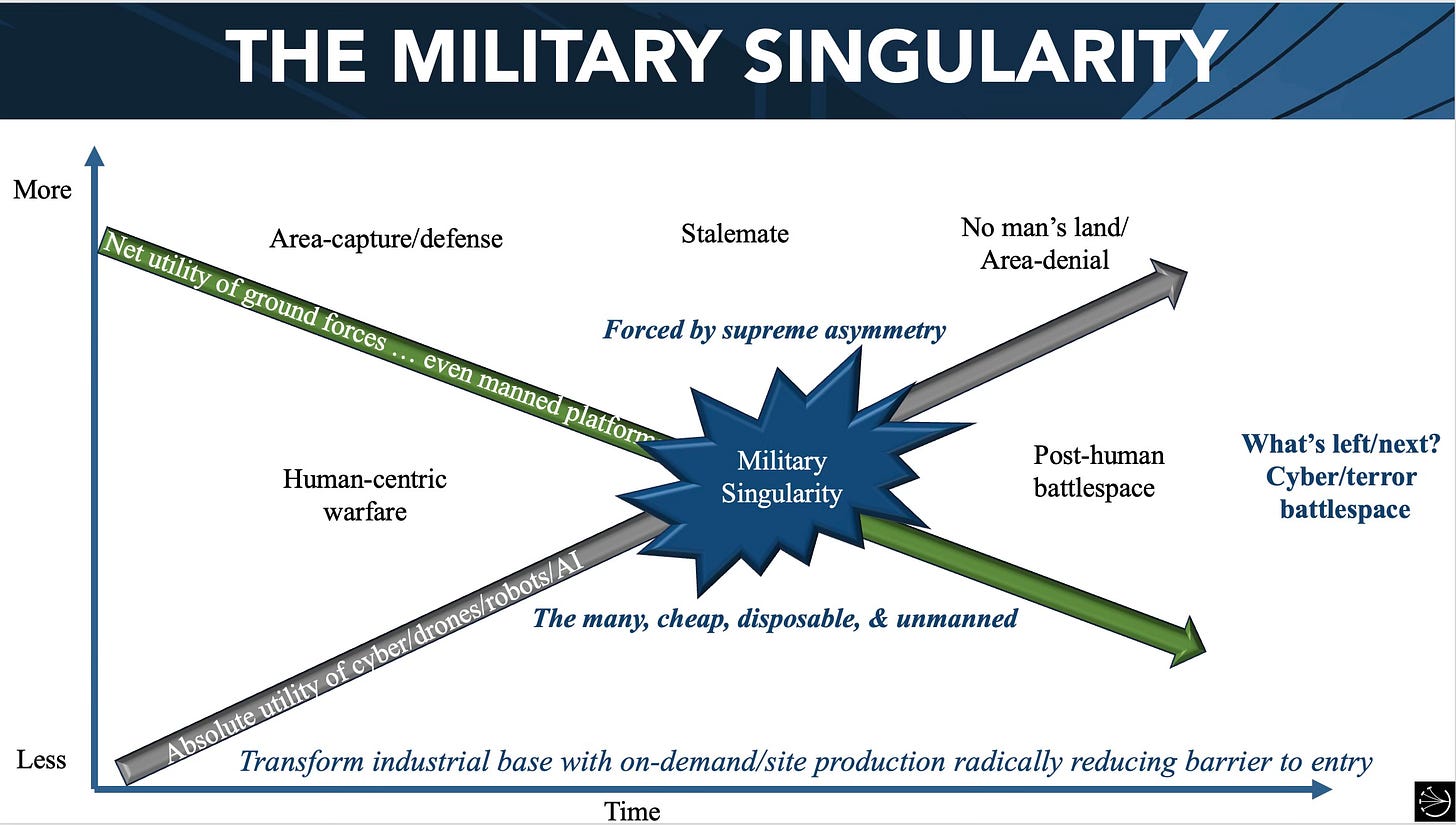The sum of all fears
Stacking our enemies on top of one another overstates the threat, as recent events clearly indicate
Since the end of the Cold War and the ultimate military force-sizing standard it provided (Red Army), the Pentagon has been in search of the right successor.
Back in the early 1990s, when I started in this business, we actually toyed with the idea of a re-risen Japan (Read Michael Crichton’s “Rising Sun”! I was told by more than a few military officers) — briefly. There was always the faint hope of a “reconstituted” Russian threat (now looking more depleted by the day in the battlefields of eastern Ukraine). China wasn’t on the radar. Terrorism really wasn’t a thing.
But then, so early in our re-thinking of the world, Saddam Hussein came along to invade Kuwait and the Axis of Evil was suddenly born — only to lack that historic moniker until being christened by George W. Bush about a decade later.
If we couldn’t have a primary force-sizing equivalent, then we decided to stack these three on top of one another and contemplate (since they were an axis!) simultaneity — a fancy word for them attacking (somebody, maybe each other in the case of Iran and Iraq) all at once.
Thus the Pentagon spent the bulk of the 1990s, right up to the declaration of the Global War on Terror (also by Bush) in 2001 in response to the 9/11 terror strikes, worshiping at this particular force-sizing altar: What if North Korea invaded South Korea while Iraq invaded Kuwait again and maybe Iran would target Saudi Arabia or Israel? How would we handle all three at the same time?
Cool beans, to say the least.
But also a bit sloppy and internally inconsistent. Still, it sufficed, because that rather fantastic scenario gave us a big target that substituted for the old Soviet one, and thus we made do … until the GWOT was declared and we got into the business of toppling enemy regimes and dealing with their messy aftermaths (reluctantly).
Once we toppled regimes in Afghanistan and Iraq, that follow-up became — by default and intense demand — the major force-sizing-and-reordering principle forced upon the Pentagon by real-world events, and it raised a ton of planning issues. How many of these could we handle at a time? What differing platforms and formations and equipment might we need to not only take down a regime but to rebuild one in its place (infinitely harder)? How to balance all these new responsibilities with keeping an eye on old ones like Iran and North Korea, etc.?
Very messy.
Into that mess strode Vice Admiral Arthur K. Cebrowski, just then retired and named by SECDEF Donald Rumsfeld to head up a new unit in OSD (Office of the Secretary of Defense) called the Office of Force Transformation (OFT). That island of misfit toys was to become home to a cluster of network-centric warfare (NCW) types, to include me even though I was best known then as a critic of NCW who nonetheless hit it off with Art, who became a key mentor.
Our arguments were many and — quite frankly — all over the place as these things tend to be when seeking bureaucratic liftoff.
My core idea, promulgated in The Pentagon’s New Map (which I briefed EVERYWHERE and to EVERYONE in those days, thus earning its own Wikipedia entry), was that we were building one force (Big-War warfighting Leviathan) but mostly operating another (the small-wars System Administrator force). That was infinitely stressing on the personnel. The Leviathan was mostly “blue” (Air Force and Navy), while the SysAdmin was mostly “green” (Marines, Army, Spec Ops).
My message was simple enough: it’s highly distressing to buy primarily for the Leviathan but then run your SysAdmin ragged with ops around the world, so why not acknowledge that split and turn the Department of Defense back into the Department of War and set up another department to deal with the “everything else” — or a combined civilian/military and public/private mixture that would focus on making sure that every military intervention by the Leviathan would end up leaving the country in question MORE connected to the outside world than before?
I always pitched the SysAdmin (see my TED talk) as more civilian than military, more USG than DoD, and — ultimately — more private-sector than public sector.
[NOTE: As I look back now, I recognize China’s Belt and Road Initiative as the closest approximation of my SysAdmin force — and a profoundly powerful one at that.]
Those within the US military stuck doing SysAdmin work loved my framework because it reflected their operational reality. Those who worked the Leviathan Big-War side of the equation saw only a budgetary threat (and it was one) and so derided it as “make-believe.”
Fast-forward through some “endless wars” in which America proves incapable of sharing power with regional players in the subsequent “winning the peace” part and the US public naturally tires and we sequentially pull out of Iraq and Afghanistan (even as events keep pulling us back in, Michael Corleone-style): We’ve been in retreat from such global ambitions/responsibilities since Obama’s election in 2008 and Trump’s return only extends that process further (MAGA has no military force-sizing principle but rather a desire to de-woke the institution and, by doing so, “making it great again”).
Within the DoD, this decade-and-a-half-long retreat has allowed the Big War forces to reassert themselves, with China as the preferred force-sizing target, but then Russia’s invasion of Ukraine … Iran’s emergent “axis of resistance” … and Kim’s continued shenanigans in NorKo … and this whole package started getting repackaged as this new Axis of Evil with plenty of references to the 1930s and the notion that — of course — we’re on the verge of WWIII (or, it’s already begun, per so many Sky-is-Falling types).
But then a funny thing happened on the way to the WWIII coliseum … the drone-ification of Ukraines’ resistance has been THE eye-opener that, combined with the rise of AI and robots, etc., now suggests that the old OFT mantra of the many, the cheap, the disposable, and the unmanned has finally arrived as THE NEW FORCE-SIZING paradigm — the Military Singularity achieved.
Now, in just the last two years, the US military has jumped from this very traditional high-tech war concept with China over Taiwan to this radically new vision of a “drone hellscape.” Meanwhile, inbound government-reshaper Elon Musk derides manned aircraft (and platforms in general) as a complete waste of time in the Age of Drones (and there I agree with him for the most part).
That stunning development (first foreseen by OFT two decades ago) now undercuts the notion of having to resort to this stacking of enemy threat packages (Russia + China + NorKo + Iran & Co.), which itself is now … kind of … falling apart before our very eyes.
First and most recently: the fall of the Assad regime in Syria, combined with the military setbacks suffered by Hamas and Hezbollah and the Houthis and Iran itself over the last year-plus, suddenly leaves the dreaded Axis of Resistance in operational shambles.
Then there’s Russia’s increasingly desperate situation with Ukraine, which is draining the Kremlin of both blood and treasure at an unsustainable rate — so much so that help from lowly NorKo has been obtained (a sign of great weakness and not strength).
Russia, so occupied, basically cut and ran in Syria.
Iran, similarly stressed by Israel’s post-Oct 7 Revenge Tour, also cut and ran in Syria.
Meanwhile, Xi Jinping’s decision to start purging his top military ranks under the always convenient (and typically accurate) rubric of “corruption,” signals that maybe … just maybe … the whole gotta-invade-Tawain-NLT-2027 (magical anniversary date of the CCP’s founding) is likewise falling apart in its momentum, if only for the reason that Beijing, looking at turmoil and vulnerability in both Tehran and Moscow, can’t be feeling all that good right now with Trump 2.0 teed up.
Keep reading with a 7-day free trial
Subscribe to Thomas P.M. Barnett’s Global Throughlines to keep reading this post and get 7 days of free access to the full post archives.







